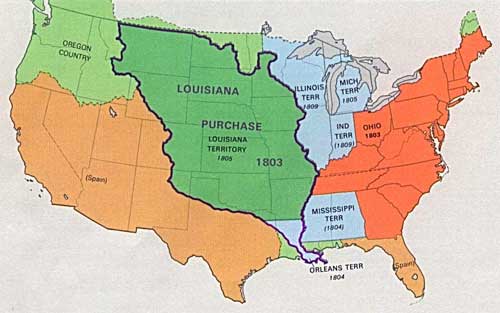The Munsons of Texas — an American Saga
Inset 9
THE UNITED STATES ACQUIRES THE LOUISIANA TERRITORY
"Let the Land rejoice, for you have bought Louisiana for a Song."
—Gen. Horatio Gates to President Thomas Jefferson, July 18, 1803

The Louisiana Purchase
As the European games of war continued with New World possessions being part of the booty to the victors, a victorious Napoleon forced Spain to give New Orleans and the remains of the original Territory of Louisiana back to France at the Treaty of San Ildefonso in the year 1800. This turn of events was much to the consternation of President Thomas Jefferson. The western areas of the new nation were rapidly being settled by industrious farmers, and the Mississippi River and the port of New Orleans were the only export outlets for their farm produce. Spain had been a friend, but there was fear that France might try to close this route.
Jefferson sent Robert R. Livingston and James Monroe to Paris in an effort to purchase the port city of New Orleans. They let it be known that the United States was prepared to join with France's enemy, Britain, and the then dominant British navy, in order to keep this route open, if necessary. Napoleon feared that war with Britain was inevitable, and that he could not hold Louisiana against the British navy, and, as always, he needed money. Napoleon's minister, Talleyrand, in a surprise move, offered to sell not only New Orleans, but the whole province of Louisiana for $15,000,000. Livingston and Monroe accepted and brought the news back to an astonished Jefferson. Jefferson was not totally pleased, for he doubted that the new Federal Government of the American colonies had the power under the Constitution to make such a purchase. Nevertheless, he and the Congress quickly approved the purchase, and the size of the new nation was almost doubled.
For many years the boundaries between all of Spanish Florida and the English and American colonies were unsettled and remained in dispute. At the Treaty of Paris in 1783, England and Spain agreed upon a boundary. This would be the St. Mary's River from the Atlantic Ocean to a certain point, from there a diagonal line westward to a certain point on the Chattahooche River, and then the 31st parallel of latitude west from the Chattahooche River to the Mississippi River. This line separated Spanish Florida and West Florida from the United States for many years, until the United States purchased Florida from Spain in 1819, and it has remained as the state lines for Florida, Alabama, Mississippi, and Louisiana to this day. The 31st parallel became an important dividing line, first between the Natchez District and the District of New Orleans and later between the states of Mississippi and Louisiana. Even though Jesse and Robert Munsons's land-grants were two miles south of this line, they were under the administration of the Natchez District.
